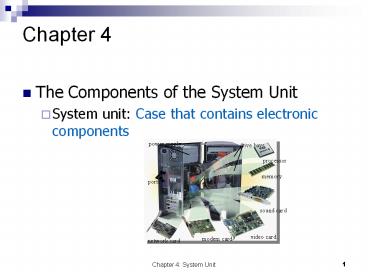The Components of the System Unit - PowerPoint PPT Presentation
1 / 21
Title:
The Components of the System Unit
Description:
Generates regular electronic pulses that set operating pace ... Electronic components store instructions, data, and results. Consists of chips on. motherboard ... – PowerPoint PPT presentation
Number of Views:98
Avg rating:3.0/5.0
Title: The Components of the System Unit
1
Chapter 4
- The Components of the System Unit
- System unit Case that contains electronic
components
2
Motherboard
- Main circuit board in system unit
- Contains adapter cards, processor chips,
andmemory chips
p. 128 Fig. 4-3
3
Processor
- CPU
- Interprets and performs basic instructions
- Control unit coordinates operations
- ALU performs math functions
Arithmetic Logic Unit (ALU)
Control Unit
Memory
InputDevices
OutputDevices
Data
Information
StorageDevices
p. 128 Fig. 4-4
4
System Clock
- Controls timing of all computer operations
- Generates regular electronic pulses that set
operating pace
Pace of system clock is clock speed Most clock
speeds are in the gigahertz (GHz) range (1 GHz
one billion ticks of system clock per second)
p. 130
5
Processor
- Faster processor, more expensive
p. 131
6
Data Representation
- How do computers represent data?
- Recognize only two discrete states on or off
- Use a binary system to recognize two states
- Bytes eight bits
p. 132 Fig. 4-6
7
Data Representation
- Eight bits grouped together as a unit
- Provides enough different combinations of 0s and
1s to represent 256 individual characters
- What is a byte?
p. 132 Fig. 4-7
8
Data Representation
- What are three popular coding systems to
represent data?
- ASCII personal computers
- EBCDICmainframes
p. 132 Fig. 4-8
9
Memory
Seat 2B4
Seat 2B3
- What is memory?
- Electronic components store instructions, data,
and results - Consists of chips on motherboard
- Each byte stored in unique location called an
address
p. 134 Fig. 4-10
10
Memory
- How is memory measured?
- By number of bytes available for storage
p. 134 Fig. 4-11
11
Memory
- What is random access memory (RAM)?
Most RAM is volatile, it is lost when
computers power is turned off
Memory chips that can be read from and written
to by processor
The more RAM a computer has, the faster it
responds
p. 135
12
Memory
- How much RAM does an application require?
- Software package indicates RAM requirements
- For optimal performance, need more than minimum
specifications
p. 136 Fig. 4-14
13
Memory
- What is cache?
- Helps speed computer processes by storing
frequently used instructions and data - L1 cache built into processor
- L2 cache slower but has larger capacity
p. 137
14
Memory
- What is read-only memory (ROM)?
The data on most ROMchips cannot be modified
Memory chips that store permanent data and
instructions
p. 137
15
Memory
- What is flash memory?
- Nonvolatile memory that can be erased
electronically and reprogrammed
p. 137 Fig. 4-15
16
Memory
- What is CMOS?
p. 139
17
Expansion Slots and Adapter Cards
- What is an expansion slot?
- An opening, or socket, on the motherboard that
can hold an adapter card
p. 140 Fig. 4-19
18
Ports and Connectors
- What is a serial port?
- Transmits one bit of data at a time
- Connects slow-speed devices, such as mouse,
keyboard, modem
p. 142 Fig. 4-23
19
Ports and Connectors
- What is a parallel port?
- Connects devices that can transfer more than one
bit at a time, such as a printer
p. 142 Fig. 4-24
20
Ports and Connectors
USB (universal serial bus) port
- What are USB ports?
p. 142
21
Buses
- What is a bus?
- Channel allows devices to communicate with each
other - Connects processor and RAM
Access times RAM, hard drive, floppy
p. 144 Fig. 4-25































